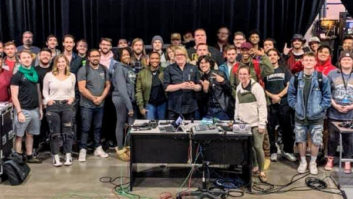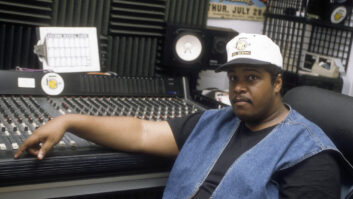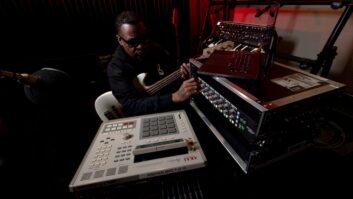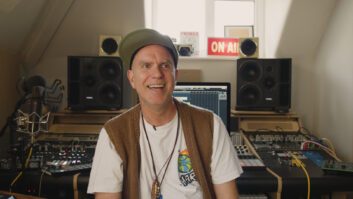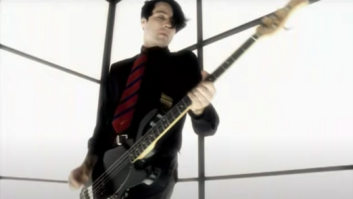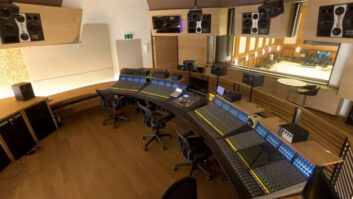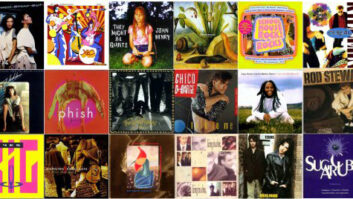Although Tommy LiPuma has been in the record business for nearly 40 years and has 18 Gold and Platinum records, 30 Grammy nominations and several Grammy awards, the past is the furthest thing from his mind.
This veteran started as a professional saxophone player in the late ’50s and has made a habit of producing high-quality pop/jazz records that break out as huge hits (George Benson’s monster Breezin’; Natalie Cole’s Unforgettable; albums by David Sanborn, Bob James and Al Jarreau), but he is looking forward instead of back; it’s easily understandable after just a peek at the top of his artist roster at The Verve Music Group (where he is chairman). There are the blazingly brilliant young pianists Eric Reed and Danillo Perez, and the young, talented Canadian jazz singer/pianist Diana Krall. Not to mention the still wonderfully active hard bop master, Horace Silver.
LiPuma is most anxious to talk about the recently released Diana Krall record, When I Look in Your Eyes, the follow-up to Love Scenes (also produced by LiPuma), which has sold almost like a pop record, moving the better part of a million units worldwide.
The new record features Krall with orchestral arrangements by Johnny Mandel (also co-producer with LiPuma on six of the record’s 12 tracks) and her regular accompanists-guitarist Russell Malone (a leader and Verve Music Group recording artist in his own right), bassists Ben Wolfe and John Clayton, and the great drummer Lewis Nash, among others.
LiPuma, a former song-plugger and Liberty Records promotion man, is well aware that with the mediagenic Krall and her new record he has the chance for another big crossover success. In his desk-less corner office overlooking the Hudson River on Manhattan’s West side, the soft-spoken producer needs little urging to discuss the ins and outs of capturing the essence of a hot, young crossover jazz star.
What’s step one for you in approaching a new record, for example, with Diana Krall?
I’m very much into pre-production. It is one of the most important aspects of making a record. The more you’re prepared as things come up, the quicker you’re able to respond. Deciding on the material is a crucial part of this phase. Once you have the songs, then it’s time to start working it out, through rehearsals with the act, which is usually the best way. You get some sense as to what the form is and what will happen before it happens.
How involved are you in picking the material?
In Diana Krall’s case, she is not a self-contained writer/performer. So sometimes she’ll walk in with a good portion of the material and so will I, and we’ll pick from both columns. The bottom line is that she has to know, whatever the song and whoever brings it in, that she can turn it around and make it hers.
As a case in point, take “I’ve Got You Under My Skin” from the new record. The song was her idea, and when I heard she wanted to record it I thought, “What does she have in mind?” I thought it would have to be something quite unique to take away from the all-time version, Frank Sinatra’s. Fortunately she had a chance, because she works live constantly, to develop her approach onstage. So I went to a gig and got the idea right away of what she was thinking-it’s a languid Bossa Nova arrangement that bassist Ben Wolfe and guitarist Russell Malone and Diana worked out.
We started in March 1998 looking for material, and in May got more into it and kept looking right up until the week before the date, last fall. She came to the rehearsal studio at my weekend place and spent the days finalizing the material and the evenings going over things with John Clayton, her friend and a bassist who performs on the record. He was a big help to her with things like the voicings on the chords.
We went through 50 to 75 songs and ended up with 14 to 15, 13 of which we ended up feeling good about. Some things we cut just didn’t come off.
Speaking of material, how did you come to record the remarkably delicate and intimate, and somewhat obscure, “Garden in the Rain” for the previous album, Love Scenes?
I grew up with that song, the Four Aces record. That version was not a ballad; it had a mid- to uptempo feel and was rather boisterous. It was one of the first records to use that eighth-note piano sound in the background, and it was just around the time of, or just before, Bill Haley broke out.
“Garden in the Rain” is a perfect example of Diana’s artistry and talent. She turned it into the most beautiful ballad, which is extremely appropriate, as the song’s simple lyrics are among the most incredible of any standard ever.
Are her records cut in three days as is typical in jazz today?
We gave ourselves five days and did it in four. On the previous record, Love Scenes, we did five days and we came back because we had an abundance of things in minor mode, and so went back to the drawing board and found some uptempo things and went back six weeks later and did some more recording.
No matter how prepared you are, until you finish and listen, you may not have a sense of whether you’re really on target. Every time you go into a studio, it is a crapshoot.
Sometimes you get a fabulous performance but something happens that is just not quite right. But if something happens that is really magic but there’s a minor problem, you have to make the mental note because I feel you’re better off trying to repair something that’s got a real sense of magic-repair a bar or phrase here and there-than trying to go back and repeat the whole thing and get everything right, but the feel isn’t there.
Are you working digitally?
No, I’m still an analog guy. There are certain mechanical aspects to making such fixes that would be easier with digital. But you still have to make sure that the setup of the players in the studio is such that you have that latitude, because we do everything live-vocals, everything. With Diana, we do her vocals and piano all at once. On the new record, only the orchestra was overdubbed.
Engineer Al Schmitt puts a big piece of plywood over the front of the piano to separate the piano and vocal mics, and he raises the piano top as high as it will go and covers it with a blanket. Diana’s in a rather good-sized isolation booth, one of two in Avatar Studio A in New York, which is one of the few big, high-ceilinged rooms in New York. High ceilings are important to me. Al likes to put two mics way up high and mix in the room’s ambience as he sees fit.
Diana’s in one booth, and the bass is in the other adjacent to her. So if we do have to fix a bass note, we don’t have to worry that the note has leaked into the piano mics.
Occasionally she’ll play the wrong voicing on a chord, and we have to go in and replace a piano part, which is the hardest. Without sections with abrupt stops, you have to try to get in on the downbeat so you won’t hear the ambience. If you try to punch-in in the middle of a note, forget about it.
How much are you involved with the technical aspect of recording?
As little as possible. That’s why I work with the recording engineers of the caliber of Al Schmitt; we’ve been friends since 1962 and have worked together since the early ’70s. We know each other, we anticipate each other’s moves, and that’s the best kind of working relationship to have. And Al is a master at recording acoustical music.
You were talking about feel. With Diana Krall, what comes to mind is a certain intimate texture of her voice. How do you get there?
There’s nothing out of the ordinary. We use a Neumann U67-one of mine. I own several, but I’ve been using this particular one for six or seven years, and it sounds just beautiful. I’ve used it with Natalie Cole, Anita Baker, just about everyone I’ve recorded in the past few years. It is a beautiful-sounding microphone.
Is this microphone better than other U67s?
That’s so subjective. I’ve heard others that sound as good, but why take a chance on a mic you know vs. one you don’t? There are certain studios, such as Bill Schnee’s studio and Ocean Way, that started buying these mics when everyone was going to dynamics; these guys just bought all of these tube mics. And now everyone’s going back to them. You can’t beat a tube mic.
How about her phrasing? It’s not a casual approach.
No, but every performance is different. That is what makes a great artist; every time they do it, it is not going to be the same.
So each of Diana’s takes will have significantly different phrasing? That’s kind of hard to believe, as it seems so deliberate.
Absolutely; there are no two takes that I’ve ever heard that are the same.
So it’s a question of when is that special one going to drop out, and the only thing you can really do to help it is to just set the mood and the atmosphere in the room to the point where the artist forgets themselves.
How do you do that?
Once you get everyone comfortable with what they’re hearing, it starts happening. Then, on any one date, the most difficult thing is getting that great first take. You get that first one and it is great, then you’ve done it and you know it ’cause you’ve heard it! Then it’s just a question of going straight ahead. That doesn’t mean songs will just pop out; every song has different approaches to it, and every take is another challenge.
There is one thing I do that I haven’t heard of too many other producers doing-I don’t sit in the control room. I stay in the room with the musicians.
For the first several years I produced records, I had a problem with the talkback. Everyone looks up at the control room glass at the end of the take. To push that talkback button down and then there’s that silence, you’re not hearing anything from the room-it just inhibited me. One time, I was out in the room for a rehearsal, and I asked for some headphones, and I noticed that being able to communicate with the musicians while I was right there with them was a lot easier than using the talkback. So now I always set myself up in the room with the musicians. I’m there to talk to them just as one of the musicians. I’m no more than four or five feet from anyone.
Being in the room with the musicians gives me the ability to react immediately. The other part is that there is so much going on in the booth; there are more distractions than I want to deal with, as I get distracted somewhat easily. There are also times when the musicians get an immediate sense of how I’m responding to a take. There’s eye contact and people can tell, “Oh we better start at the top!” You can’t do that through a window 20 feet away.
I’m looking for that spontaneous moment, and it doesn’t matter how you get there; everyone has their own way. You have to know how to wing it; you have to be on your feet and know how to respond to the moment.
Do you tend to do a lot of takes?
Sometimes we’ve gone as much as six or seven, but in most cases the first several are the ones.
How often is it the first?
Numerous times. Going back some years, the George Benson Breezin’ album, five out of six cuts are first takes. It’s not that we didn’t do more, but we chose the first take five out of six times.
Of course, there are a few run-throughs before you start. But when you hear it start to sound good, which is one of the great things about Al Schmitt and Bill Schnee; within a short period of time they’ll get a balance to the point where it will be good enough to use. So it won’t take a half-hour just to get the balance, after which everyone’s spent.
In the mix, the important thing is that the vocalist or soloist, whoever is the main character in the play, has to be predominant to the point where they are right there in the mind’s eye. Whatever the focal point is, it’s got to be right in your face; that’s the point. Sometimes an artist is self-conscious and wants to be mixed further into the rhythm section. But if you lose that focus, the listener’s mind will wander. It is very important that you have a sense of the main attraction being right in front of you.
I noticed that with the orchestra on the new Diana Krall record it’s very much in the background.
I was concerned that if we did it all-including the orchestra-at once, we wouldn’t be able to get the small group feel right, so we concentrated on the sense of the rhythm section and Diana. When we mixed I was careful not to lose the intimacy of her and the rhythm section; I wanted the strings to be the backdrop. Of course, when Al Schmitt records, everything is so transparent. I hear subtle things like the brushes, but it doesn’t get in the way of the vocal.
We ended up using only six orchestral tracks on the record out of the nine we cut. It wasn’t the arrangements; Johnny Mandel is a master with impeccable taste. Whatever you add, however, is ear candy, for lack of a better word, and if it doesn’t add then it is going to subtract. You have to have enough sensitivity to know when it’s taking away from what is there to begin with; and if it doesn’t need it, why do it?
The orchestral recording was done at Capitol Records’ Studio A in Los Angeles, where Frank Sinatra, Nat Cole and Peggy Lee all recorded their great sides for that label. It is, of course, a great room for orchestras and big bands. Al Schmitt mixed the record at Schnee Studios.
We worked with two 24-track machines locked, at 30 ips. We mixed to half-inch at 30 ips also. We decided for some reason not to use Dolby SR on this record as we have on the others. SR has always worked wonderfully for us, eliminating the noise and not sounding like it is running through a Dolby process, but we decided not to use it this time. At 30 ips, noise isn’t that big of a problem anyway.
We tracked the basic sessions on one 24-track and the orchestra on another. We had a 36- to 38-piece orchestra. Al probably used 15 tracks on Diana and the rhythm section alone. We had stereo piano, a direct box and a mic on the guitar amplifier and a direct pickup and a mic on the acoustic bass. It doesn’t take too long to get up to 15 or 17 tracks even just with vocal, piano, drums and bass.
Once you’ve got a performance on tape that’s been recorded well, the crucial thing is mixing and mastering. You can lose the subtleties of what happened in the studio in mastering by not paying attention. You have to get so close to the mix and how it feels. So that when you master it and you find that subtleties have gotten lost, things like it not being as warm as you thought it was before, you can correct these mistakes. These are important issues. We’ve been using Doug Sax at the Mastering Lab since the ’70s. We always walk out of Doug’s place and we feel great about the master.
You’re not only a record producer, you’re also head of the label. Putting on that hat for a moment, the temptation to want to maximize the mass-market, pop potential of someone with Diana’s talent, looks and youth must be tremendous on all sides.
She has to do it on her own terms, though. I’ll never ask Diana to do anything to make a record more applicable to this or that radio format. Neither of us work that way. The interesting thing about Diana is that she is doing it on her own terms. But she hasn’t done anything musically to change what she’s done from the first record as far as the integrity of the music is concerned.
We see an opportunity, however, to reach a wider market. I’ve also got a wonderful promotion, sales, marketing department. Credit is due there. Ron Goldstein as label president has great marketing ideas. All of these elements are very important, but one of the things that drew me to her is that even though she came out of the jazz genre the demographics at her shows is consistently 18 to 80. My brother is 79 years old and he loves these records.
Would you call this a jazz or a pop record?
I don’t think I’d call it a jazz record, not a jazz record like Betty Carter, no. But to me what I look for in an artist is style. It is one of the most important aspects. Is there something about them that sticks out? Diana has that, no matter what you call the music.
